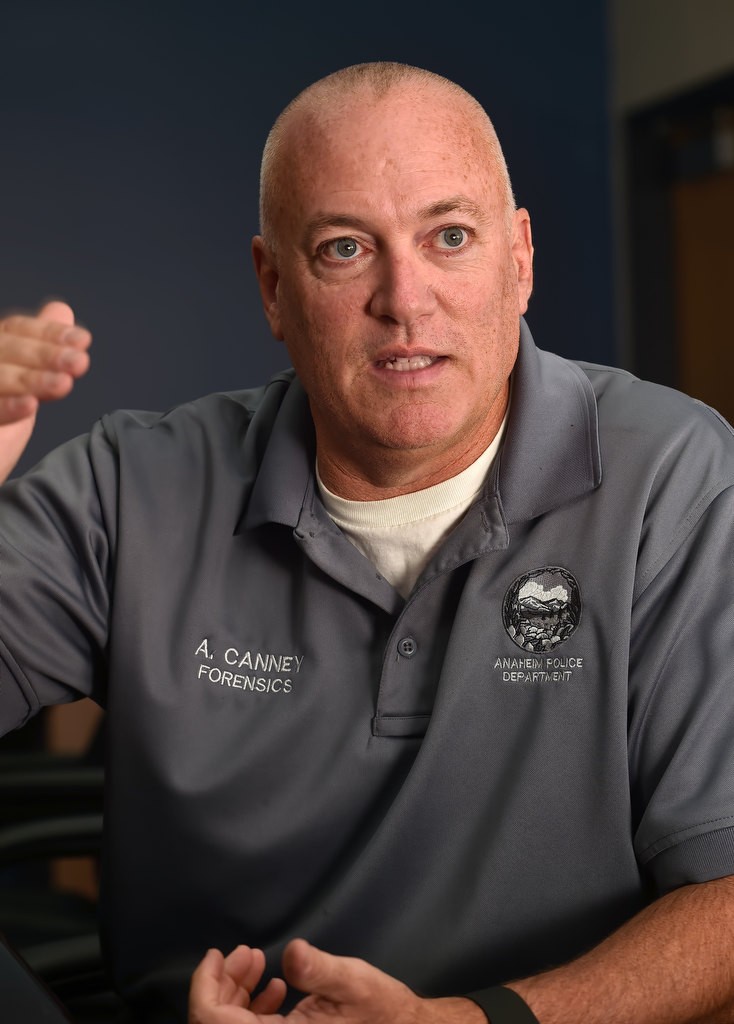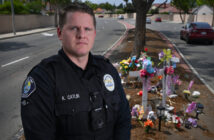When Drew Canney arrives at a crime scene, his colleagues are known to groan — good-naturedly.
That’s because Canney, one of the longest-serving specialists in the Anaheim PD’s Forensic Services unit, has a reputation for leaving no stone unturned when it comes to collecting evidence.
Heck, he’s known to insist on looking under stones outside the immediate crime scene — just to make sure he doesn’t miss anything.
“I’m meticulous,” says Canney, whose 6-foot-3-inch frame and generally stony expression could land him a role on a grisly CSI procedural (Hollywood, are you reading this?).
In his 24-year career as a forensic specialist at the APD, Canney has seen everything.
And when it comes to one of O.C.’s most notorious double-homicides, Canney was put in the unusual position of “seeing,” over and over again, the horrific details of a crime scene that spread over two cities.
***
Prosecutors often call to the witness stand a CSI expert to build their case against a defendant.
An hour or two on the stand, typically, and then it’s back to work for the CSI specialist.
But in the case of the high-profile murders on May 21, 2007 of an Anaheim Hills father and his daughter, Canney ended up taking the stand five times over the course of a few years during the trials of three suspects.
Not only was it a challenge to make sure his testimony remained consistent, but Canney, in the courthouse hallways, repeatedly saw the toll the murders took on the faces of the loved ones of the deceased, including the survivor of the attacks — the mother and wife of the two victims.

Anaheim PD’s Drew Canney of the Forensic Services Detective Division, talks about his career and how he got started with the police department.
Photo by Steven Georges/Behind the Badge OC
“These trails were tough,” Canney says. “Sometimes these things weigh on you emotionally.”
***
The last of the three suspects in the 2007 Anaheim Hills slayings, Vitaliy Krasnoperov, still is awaiting sentencing this fall for his role in the murders of Karishma Dhanak, 20, and her father, Jayprakash Dhanak, 56, and the attempted murder of Leela Dhanak, family matriarch.
This April, an O.C. jury found Krasnoperov guilty of conspiracy to commit murder.
That trial was the third for Krasnoperov, following a December 2011 conviction that later was overturned and, before that, a hung jury in May 2011.
In those three trials, Canney took the stand to testify about evidence found at the first scene of the crime, the Dhanaks’ home, which the bad guys set on fire, and at the second scene: just off a bike trail in Mason Regional Park in Irvine, where the Dhanaks’ bodies were set on fire after they had been stabbed and badly beaten.
Krasnoperov was a friend of Iftekhar Murtaza, who was convicted of the two murders in November 2013 and is on Death Row.
Prosecutors said the killings were carried out because Jayprakash and Leela Dhanak objected to Murtaza having a romantic relationship with their other daughter, Shayona Dhanak, who was not present when the vicious crimes were carried out.
The Dhanak family members were devout Hindus; Murtaza is a Muslim.
Canney also took the stand in Murtaza’s capital murder trial in 2013 as well as the trial of the third suspect, Charles Murphy Jr., in 2012. Murphy was sentenced to life without parole for helping in the attack.
***
Canney won’t divulge a lot of details about the horrific crime scenes — Krasnoperov, who is facing the possibility of 25 years to life, has yet to be sentenced.
But recently, Canney sat down to talk about his role as a forensic specialist on the headline-grabbing case and his career in crime scene investigations.
Indeed, Canney’s niche is big homicide cases.
“I like processing major crime scenes,” said Canney, 50, a single father of three grown boys, ages 25, 27 and 29.
“I like being out there. I like collecting the little pieces of evidence and putting all the pieces together to help solve the puzzle.”
Canney first arrived at the Dhanak residence early in the morning after the attacks, which happened late the night before. He was dispatched there after APD detectives had obtained a search warrant.

Anaheim PD’s Drew Canney of the Forensic Services unit: “You’ve got to be able to think outside the box.”
Photo by Steven Georges/Behind the Badge OC
Halfway through processing the complex crime scene there (the fire and subsequent water damage was extensive), Canney was sent to the location in Irvine where the two bodies were discovered.
Canney, who throughout the process was part of a team of APD forensic specialists, returned to the Dhanak residence that same evening.
“Most of the evidence literally was watered down,” he said of the home. “On top of that, the fire also burned a lot of things.”
The same was true of the scene in Irvine.
“The fire there also took away some evidence,” Canney said.
Ideally, crime scenes are not compromised so badly.
But Canney and his APD colleagues were able to process a lot of evidence, which by no means was the only evidence lead prosecutor Howard Gundy had to work with in seeking the three convictions.
After the first trial, when Canney’s testimony was limited to the inside of the Dhanak residence, he became the sole APD forensic specialist to testify when work duties prevented other colleagues from taking the stand.
Canney had to be extra careful to keep his testimony consistent each time he took the stand to prevent defense attorneys from grilling him extra hard during cross examinations.
“There wasn’t a whole lot of what we did as forensic specialists that could be questioned at trial,” Canney said, “but in the back of my mind I wondered if he (defense attorney) could slip me up. Things went well. There wasn’t anything (I testified to) that (Gundy) wasn’t able to clean up, I know that.”
***
Canney’s career in law enforcement began at the Fullerton PD as a cadet. He was 18 when he became a cadet at the suggestion of a friend.
Canney, who grew up in Placentia, served as a cadet for two years and then got into construction for a few years in the high desert, while at the same time serving as an on-call firefighter for the City of Victorville.
In 1989, Canney was hired by the San Bernardino County Sheriff’s Dept. as a forensics specialist.
“It was luck,” he said. “I happened to see a help-wanted ad, and I thought it sounded interesting.”
This was pre-O.J. Simpson double-murder trail.
Back then, the intricacies of CSI work was years away from becoming public knowledge and fodder for countless TV series and movies.
After three years working as a CSI specialist for San Bernardino County, Canney transferred to the APD, in 1992. That’s when the APD transitioned to a team of forensic specialists who were not police officers. Previously, detectives performed crime scene investigations.
These days, Canney and his colleagues perform both crime scene and fingerprinting work — unusual for a PD. Fingerprinting analysis typically is farmed out to a crime lab.
Canney says he doesn’t take his challenging work home with him. He said he has learned to compartmentalize the often-gruesome nature of his work.
“A good training officer once told me it’s best not to take things personally or get personally involved, or it will drive you nuts,” Canney said. “His advice has stuck with me.”
Canney’s outlet is sports: snow skiing, waterskiing, basketball, softball, golf. He used to coach high school football when his sons were teens. Now he mainly goes to the gym and hits the links.
Canney testifies in court about six times a year.
“You never want a hung jury,” he said. “You want to make sure whatever you can do in your testimony to provide as much information to help the jury come to a decision.”
He looks forward, he says, to the next complex crime scene — not that he wishes evil to befall on anyone.
“You’ve got to be able to think outside the box,” Canney says of being an effective forensic specialist. “I need to have a picture in my mind of possibly what happened at a crime scene and to at least be able to formulate some idea of how the crime happened, and why it happened, before I can go home and sleep.”
 Behind the Badge
Behind the Badge



